Introduction
Scaling a SaaS brand isn’t just about building a great product; it’s about sustaining momentum across a long, complex, and competitive buying journey.
Yet many SaaS teams hit the same inflection point: CAC keeps climbing, sales cycles stretch longer, and high-intent leads stall somewhere between demo and deal.
Despite producing content regularly, the results don’t align with the pipeline. Traffic may rise, but conversions plateau. Product launches go unnoticed. And content that once felt strategic becomes just another box to tick.
Why does this happen?
Because while content is one of the most powerful growth levers for SaaS, it’s also one of the most misunderstood. Most in-house teams are strapped for time or lack the specialized expertise to align content with buyer stages, SEO intent, and go-to-market (GTM) motions.
Meanwhile, generic content agencies fail to grasp the nuances of SaaS: complex products, multiple personas, and a funnel that doesn’t follow a straight line.
The result? Content that reads well but doesn’t perform. And a marketing function that struggles to prove its impact on growth.
If this sounds familiar, you’re not alone. The better question is: What would it look like if your content engine actually accelerated your sales, supported product launches, and built long-term compounding traffic?
That vision is entirely achievable, but only when content is treated not just as a brand asset, but as a strategic, cross-functional growth driver.
So let’s start there: if content is the most scalable lever in SaaS, why are so many brands under-leveraging it?
Why Content Is the Most Under-Leveraged Growth Lever
SaaS teams know content matters, but most aren’t using it to its full potential.
Too often, content is seen as a brand awareness tool. A blog here, a product update there. But content can do far more than just drive traffic. It can accelerate go-to-market, nurture leads, support customer success, and even reduce churn.
The challenge? Execution.
According to the Content Marketing Institute, only 29% of B2B marketers say their content is “very effective”, despite the fact that 74% say it drives demand and leads.
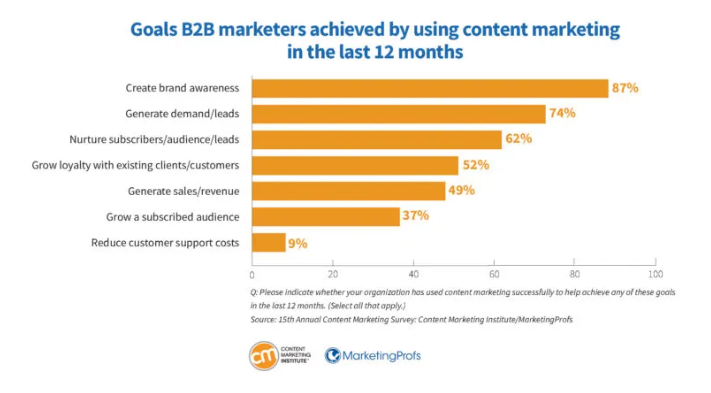
So what’s going wrong?
- Teams overinvest in TOFU content but neglect the middle and bottom of the funnel.
- Content isn’t mapped to buyer intent or sales motion.
- Launches happen, but content support is delayed or missing.
- Generalist writers lack the product knowledge to educate or convert technical buyers.
The result? Content that gets views, but not sign-ups. SEO that ranks, but doesn’t drive revenue.
In SaaS, great content isn’t just about volume; it’s about strategy, structure, and alignment. Which raises a bigger question: If content is this important, why do so many SaaS brands hand it off to generalist agencies?
Let’s look at why that almost always backfires.
Traditional vs. Specialized: Why Generic Agencies Fail SaaS Brands
When SaaS companies decide to outsource content, they often turn to generalist agencies.
But the problem is that most of these agencies are built for B2C, short sales cycles, or basic SEO, not the layered complexity of B2B SaaS.
They may deliver clean writing and meet deadlines, but here’s what’s usually missing:
- Strategic depth: Content calendars built around keywords, not GTM priorities or sales enablement needs.
- SaaS fluency: Little understanding of PLG motions, buyer journeys, or how SaaS users actually evaluate products.
- Persona misalignment: Messaging aimed too broadly or written for the wrong decision-makers entirely.
- Execution gaps: No support for feature launches, product marketing, onboarding, or post-sale enablement.
Which results in content that ranks, but doesn’t convert. Blogs that generate traffic, but not MQLs. Assets that “look good” but lack impact.
Let’s break it down:
You don’t just need more content, you need the right content, delivered by a team that understands how SaaS brands grow.
So what exactly does a SaaS-specialized agency bring to the table that generic ones can’t? Let’s dive in.
5 Core Benefits of a SaaS-Focused Content Marketing Agency
When you work with a generalist content agency, you get deliverables. But when you partner with a SaaS-focused content marketing agency like Revv Growth, you get strategic leverage that fuels faster growth.
We’ve worked with many SaaS brands to create systems that drive qualified traffic, speed up go-to-market motion, and support every stage of the buyer journey. Here's how that plays out across five core benefits:
1. SEO-Driven Traffic Growth
For SaaS brands, traffic only matters if it leads to the pipeline. That’s why we don’t chase vanity metrics, we build search-first content that attracts, qualifies, and converts.
What we do:
- Topic clusters based on real buyer searches: We analyze search behavior, identify high-intent, niche keywords, and build interconnected content hubs that dominate SERPs and AI-powered search tools.
- Intent mapping at the core: We map keywords to funnel stages so your content captures buyers who are researching, comparing, or ready to book a demo.
- Technical SEO is built in: From clean structure to internal linking and schema, we ensure content performs, not just looks good.
In our "Top ABM Agencies" blog, we didn’t just rank; we outranked top sites by combining SEO research with decision-stage framing. The blog ranks on Google and shows up in ChatGPT and Perplexity AI Overviews.
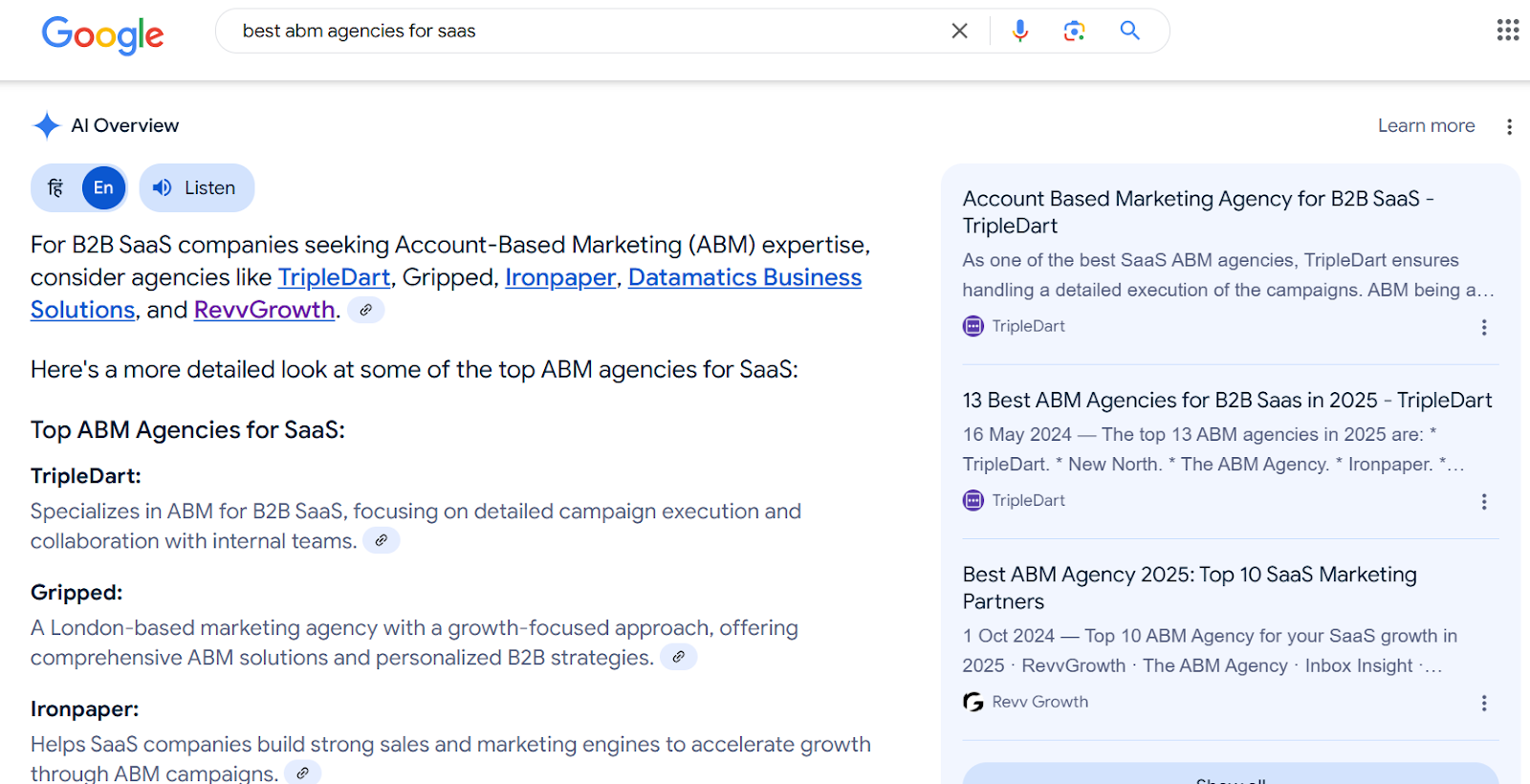
2. Scalable, Systemized Content Operations
Without a systemized approach, even great content strategies stall in the pipeline. Specialized SaaS agencies solve this by building repeatable workflows that allow you to ship faster, with less internal lift, and greater performance upside.
See how we did it with Atlan.
Atlan, a fast-growing data collaboration platform, wanted to increase organic traffic without relying on paid media. Their goal: rank for high-intent, competitive keywords in the data catalog and operations space, and secure featured snippets to boost click-through rates.
Here’s how we helped them scale content fast, without sacrificing quality:
- AI for scale and speed: We used tools like ChatGPT, Perplexity, Claude, and Frase to automate content ideation, outline generation, and semantic optimization. These tools were calibrated to produce snippet-friendly formats, definitions, lists, and structured answers.
- Human oversight for quality: Our SaaS-native editors refined every draft to ensure accuracy, brand consistency, and strategic depth, reinforcing Google's E-E-A-T (Experience, Expertise, Authoritativeness, Trustworthiness) principles.
- Smart topic intelligence: We identified high-potential keywords through AI clustering and real-user pain point mining from forums, Reddit, and Slack communities. This ensured the content matched not just what users search, but how they search.
- Automated content ops: We built a Notion-to-CMS (CloudCannon) pipeline that took each piece from brief to publish with minimal delays, eliminating bottlenecks and reducing time to live.
The results:
- Over 130+ long-form SEO blogs published monthly
- Multiple Google featured snippets secured within months across competitive queries
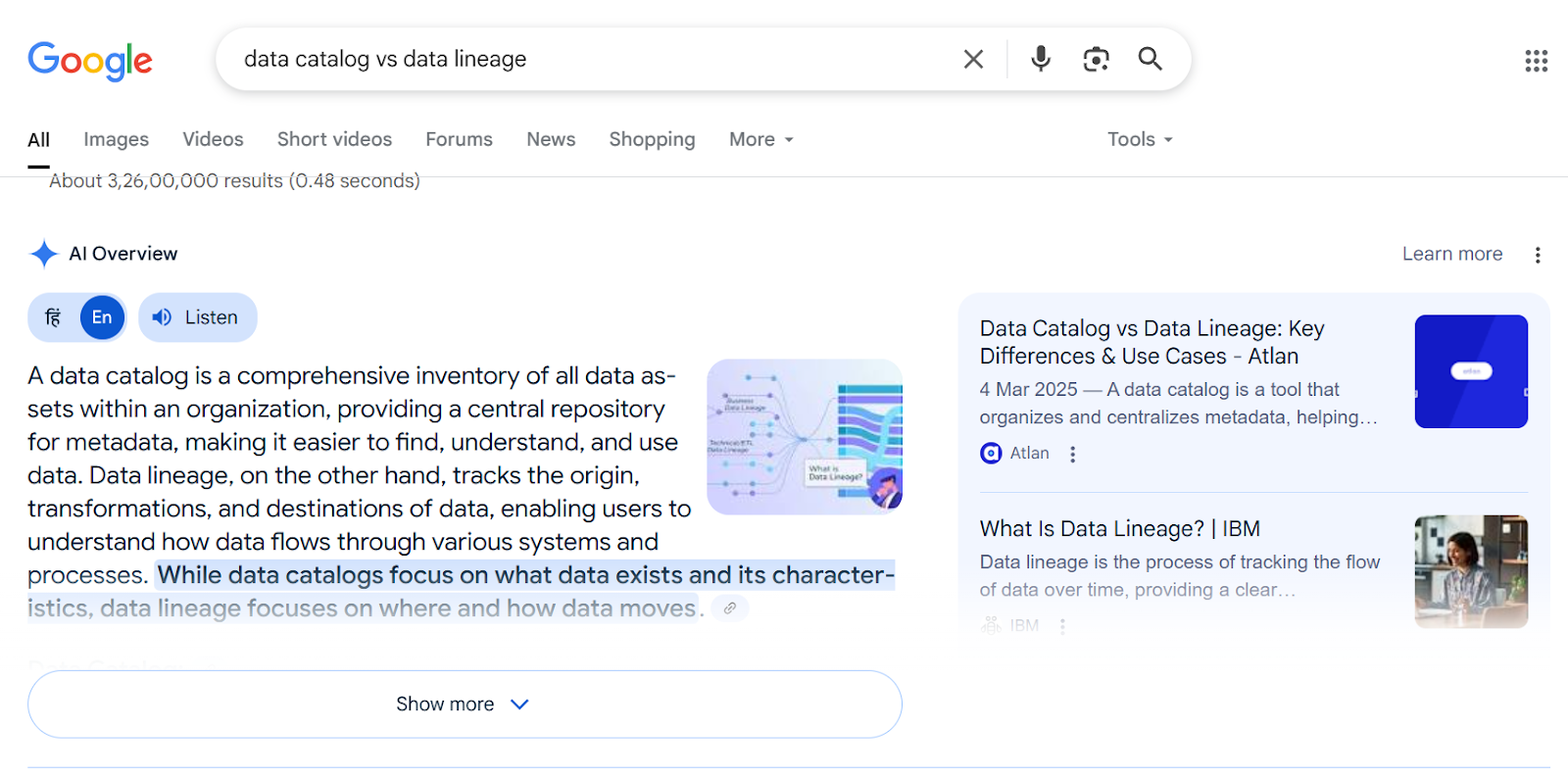
- Significant organic traffic growth with zero paid media spend
- Sharp increase in blog CTRs due to snippet placement and high relevance
- SERP dominance, with Atlan content featured in AI search tools like ChatGPT
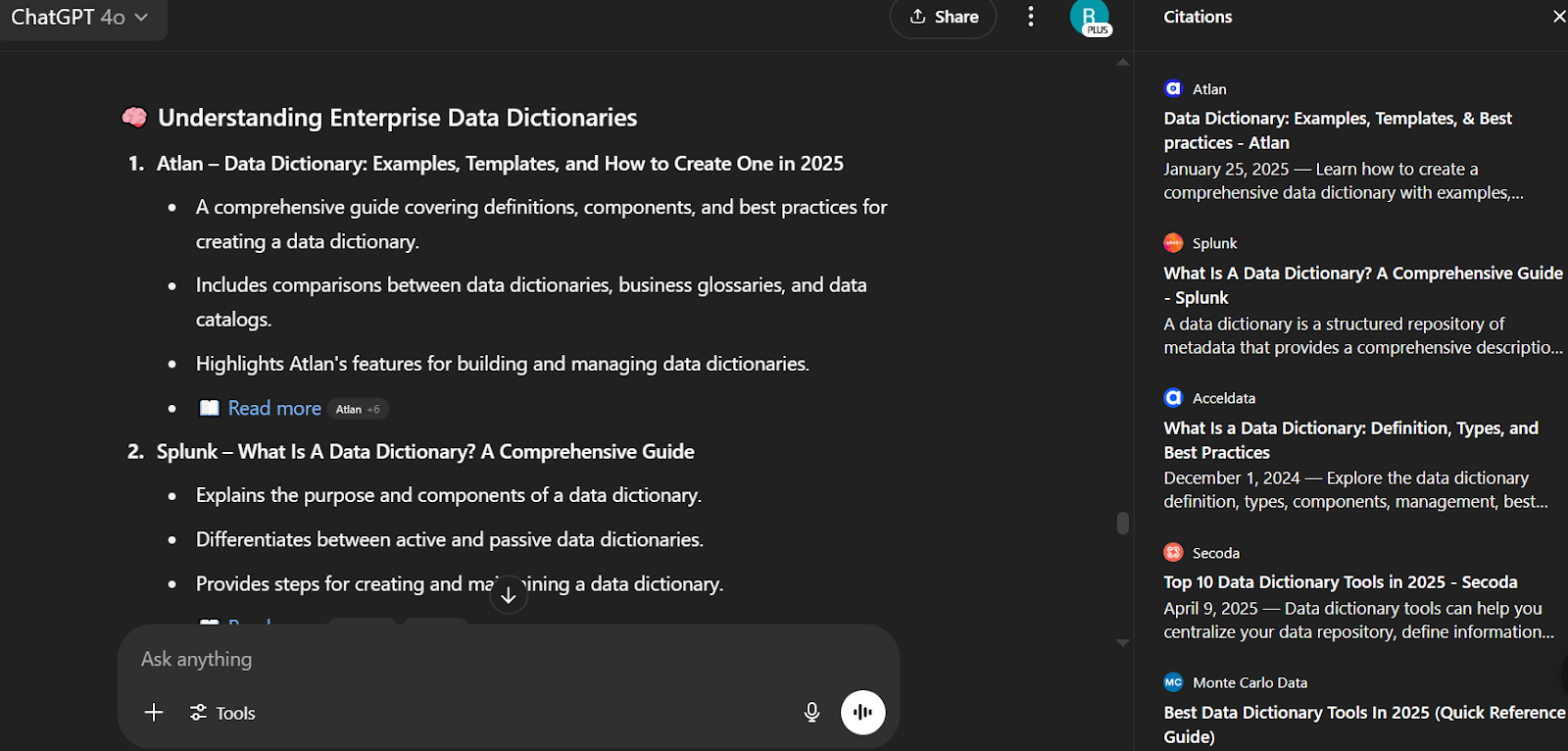
Scaling content isn't just about publishing more; it’s about building a system that connects operations, AI, and editorial quality. With Atlan, we proved that when content workflows are optimized for both speed and substance, growth follows predictably and sustainably.
Read the full case study: The Ultimate Guide to Get Crazy Click-Through Rates
3. Faster Go-To-Market for Features & Updates
In SaaS, GTM timing can make or break a feature launch. If your content lags behind your product release, you miss the window to capture attention, educate users, and drive adoption. That’s why we embed GTM alignment into our content system from day one.
At Revv Growth, we work as an extension of your product and marketing team, so content supports your launches, not slows them down.
Here’s how we do it:
- Pre-launch planning built into strategy: We create content calendars that match your product roadmap, not just generic SEO timelines. For every major release, we map the content required across each funnel stage: SEO blog, demo page, comparison content, FAQs, product update email, and more.
- Clear content roles tied to GTM: Our strategists interface directly with product marketers to understand the “why” behind the release, and our SaaS-native writers translate that into messaging that’s crisp, technical, and compelling, across use cases and personas.
- Rapid production cycles: With our editorial systems, a GTM asset can go from draft to published in days. Internal delays are minimal because our team already understands SaaS workflows, approval layers, and the urgency of product-led motions.
- Built-in repurposing: One launch blog can be atomized into a launch tweet thread, product spotlight in a newsletter, a use-case support doc, and even a demo talking point for your sales team. This ensures the same message is reinforced across every channel, quickly and consistently.
Whether we're supporting a new integration, a pricing update, or a platform release, our clients rely on us to build launch-ready content in parallel with product builds, not as an afterthought.
Internally, we apply the same approach at Revv Growth. When we updated our SaaS content frameworks, for example, we created a full suite of GTM assets: an SEO-driven explainer blog, internal guide, LinkedIn post, and a sales pitch reference, released in sync for maximum impact.
4. Funnel-Aligned Messaging and Lead Nurturing
SaaS buyers don’t move in a straight line. One day, they’re reading a high-level strategy blog; the next, they’re comparing solutions or searching for integration-specific content. To convert them, your content has to meet them wherever they are and guide them forward.
Here’s how we build for that at Revv Growth:
- Content structured around funnel intent: Every blog, guide, and asset is designed to serve a specific buyer stage. For example:
- Our “Content Marketing Pillars for SaaS” blog targets awareness-stage readers exploring content ROI. It educates early-stage founders and CMOs about how content can influence GTM speed and pipeline, not just traffic.
- Meanwhile, our “Clay Workflow Automation” blog speaks to decision-stage marketers and RevOps teams who are actively exploring tactical use cases. It's tightly aligned with product-led growth, showing how to automate top-of-funnel and lead scoring workflows using Clay + enrichment tools.
- Our “Content Marketing Pillars for SaaS” blog targets awareness-stage readers exploring content ROI. It educates early-stage founders and CMOs about how content can influence GTM speed and pipeline, not just traffic.
- Objection-handling built into content: Whether it’s a product launch, comparison page, or use case blog, we ensure the content answers buyer doubts before sales even get involved. This creates smoother hand-offs and faster funnel movement.
- Sales and marketing collaboration: We sync with client GTM teams to align every piece of content with sales conversations, lead nurturing flows, and demo CTAs, turning content into a revenue-driving asset, not just a blog post.
When content is strategically aligned to your sales funnel, not just driven by keywords, it stops being a traffic play and starts becoming a predictable pipeline engine. That’s the core of how we help SaaS brands convert smarter and faster.
5. Customer Education and Retention Support
Acquiring users is just step one; retaining them, driving adoption, and encouraging expansion is where true SaaS growth lives. Yet, most content strategies stop at acquisition. We help our clients go further by building content that empowers customers, reduces churn, and unlocks long-term value.
Here’s how we do it at Revv Growth:
- Onboarding and help content: We create step-by-step guides, product walkthroughs, and FAQs designed to help users quickly experience value. These aren’t buried in the help center; they’re optimized for SEO, easily shared by CS, and built for clarity.
- Feature education made strategic: Instead of basic feature updates, we turn product enhancements into content campaigns. These often include use-case blogs, mini case studies, and nurture emails, designed to re-engage users and increase feature adoption.
- Content as a CS enablement tool: We work with CS teams to understand recurring questions and blockers, then create content assets that support them during onboarding, QBRs, and renewal cycles. These include “how-to” pieces, integration guides, and success story templates.
Our blog on “AI in PPC Management” not only ranks well but serves as a foundational resource for educating clients on performance marketing automation. It breaks down how AI can enhance budget efficiency, targeting precision, and campaign optimization, making it a valuable asset during onboarding, QBRs, and strategic planning calls with marketing teams.
Better-educated users are more likely to adopt features, stay longer, and expand usage. With SaaS churn often tied to unclear onboarding or underutilized features, content that drives education directly impacts retention and LTV.
How to Choose the Right B2B SaaS Content Marketing Agency
Not every content agency is built for SaaS, and the wrong choice can cost you time, budget, and traction. If you want content that drives pipeline, not just pageviews, it’s critical to evaluate your partner with the right lens.
What a Great SaaS Content Agency Must Have, let’s see:
1. Deep Understanding of the SaaS Funnel
Your agency should know the difference between content that nurtures a first-time user and content that helps close a six-figure deal. They must demonstrate experience across awareness, consideration, decision, and post-sale stages, and show how they’ve supported actual GTM motions.
2. Unified Strategy and Execution
You need a team that doesn’t just write content, but builds the strategy, maps the funnel, and manages performance. Avoid siloed setups where strategy is handed off to disconnected writers. Ask how content ideation, SEO planning, writing, and reviews are integrated.
3. SEO Expertise That Ties to Business Goals
Ranking on Google is great, but content that generates a pipeline is better. A SaaS content agency should map keywords to buyer intent, build topic clusters, and track performance based on MQLs, conversions, or influenced revenue, not just traffic growth.
4. SaaS-Specific Frameworks and Playbooks
Whether it’s launching integrations, building comparison pages, or scaling content for PLG, your agency should bring proven systems. Generic blog calendars won’t cut it. Ask if they have frameworks tailored to SaaS motions.
Key Questions to Ask
- Who owns your content strategy, and how do they stay involved in execution?
- How do you ensure content maps to different stages of the SaaS funnel?
- What frameworks do you use for SaaS-specific formats like product-led blogs or integration content?
- How do you measure success beyond traffic?
Common Red Flags to Watch Out For
- The “just send us topics” model:
This usually means you’ll be responsible for strategy, while they just deliver words. - Traffic-first KPIs with no mention of funnel goals:
If they’re not talking about qualified leads, MQL-SQL conversion, or assisted pipeline, it’s a sign they’re not thinking in SaaS terms. - Lack of alignment with your GTM or sales teams:
A strong content partner will ask about your product roadmap, upcoming launches, and sales objections, because content should support them all.
If you’re seeing some of these red flags, or aren’t sure what to look for next, we’ll walk you through a simple checklist to evaluate whether your brand is ready for a SaaS-focused content partner.
Checklist: Is Your Brand Ready for Specialized SaaS Content Support?
Bringing on a specialized SaaS content marketing agency is a strategic move, not a band-aid. If you're wondering whether now is the right time, here’s a quick way to evaluate your readiness.
1. You’ve Hit Product-Market Fit and Are Scaling
You’re no longer in MVP mode. Your product is selling, customer feedback is consistent, and you’re building out GTM functions to grow faster. You need content that amplifies what’s working, not just awareness for something new.
2. Content Gaps Are Slowing Down Sales, CS, or PMM
Your sales team keeps asking for explainers, FAQs, or case studies. CS is repeating onboarding questions. Product marketing needs help getting feature updates in front of users. If content is a recurring blocker, it’s time for external leverage.
3. Your Internal Team Is Bandwidth-Constrained
You have the ideas, maybe even some frameworks, but execution keeps slipping. Strategy, writing, reviews, and SEO all require time. A SaaS content agency helps you move fast without sacrificing depth or alignment.
4. You Need Pipeline, Not Just Pageviews
You’re not looking for vanity traffic. You want content that attracts ICPs, educates them, supports sales, and drives conversion. If your current content efforts don’t map clearly to funnel impact, a specialized team can help build that bridge.
5. You Want a Partner, Not a Vendor
You’re not looking to hand off tasks. You want strategic collaboration, proactive content ideas, and a team that understands SaaS, not one you have to teach. If this sounds like your team’s mindset, you’re ready for a true content partner.
If you're checking off most of these boxes, you're closer to being ready than you think. Next: Let’s talk about how to actually activate that content engine.
Ready to Scale With Content That Actually Converts?
If your SaaS team is producing content but not seeing impact, stalled funnel velocity, missed GTM opportunities, or low-quality leads, it’s not a volume issue. It’s a strategy and execution gap.
At Revv Growth, we help SaaS brands turn content into a true growth engine. That means building search-first content hubs, aligning messaging to every stage of the funnel, and launching fast, with systems that don’t slow you down.
Whether you’re scaling a PLG motion, supporting a sales-assisted model, or launching new features, we’ve done it across dozens of SaaS brands just like yours.
Let’s build content that fuels traffic, leads, and long-term growth. Book a strategy call with Revv Growth →

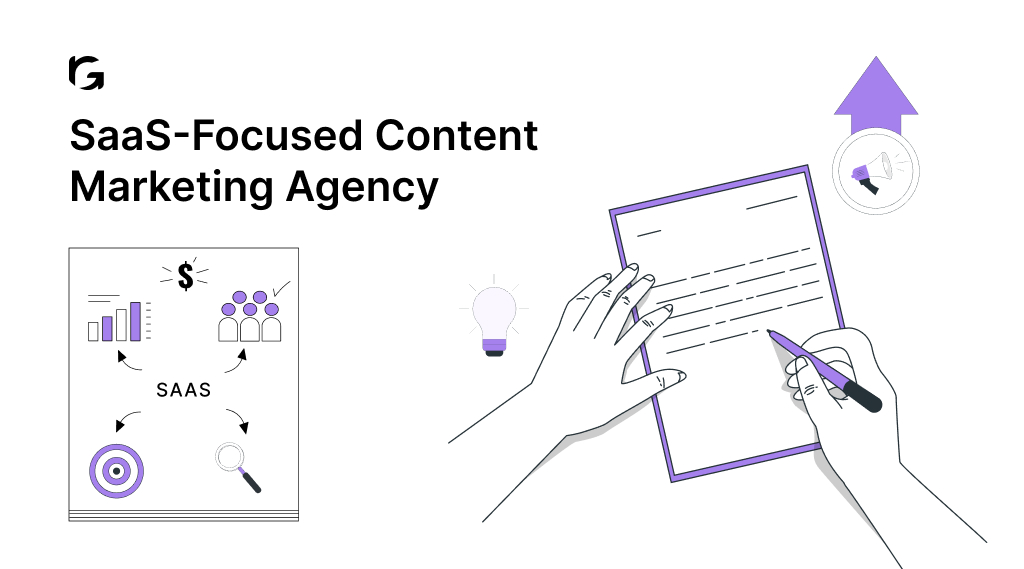

.svg)

.webp)